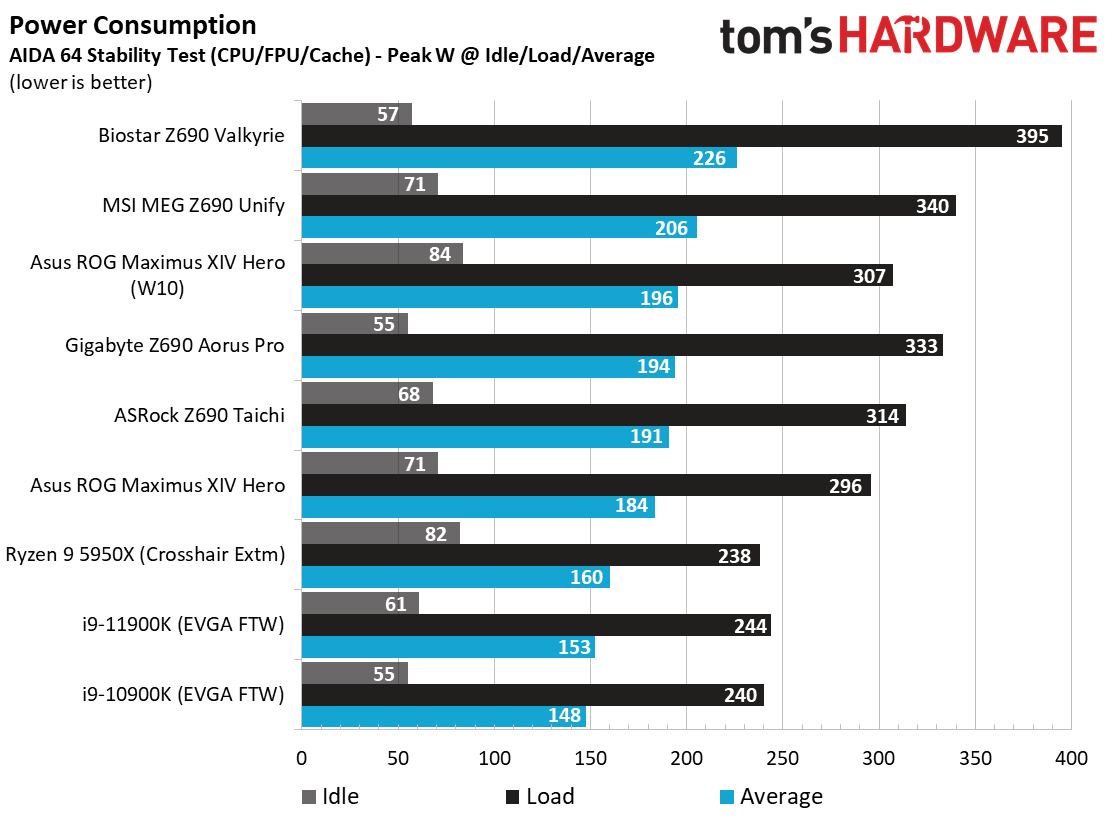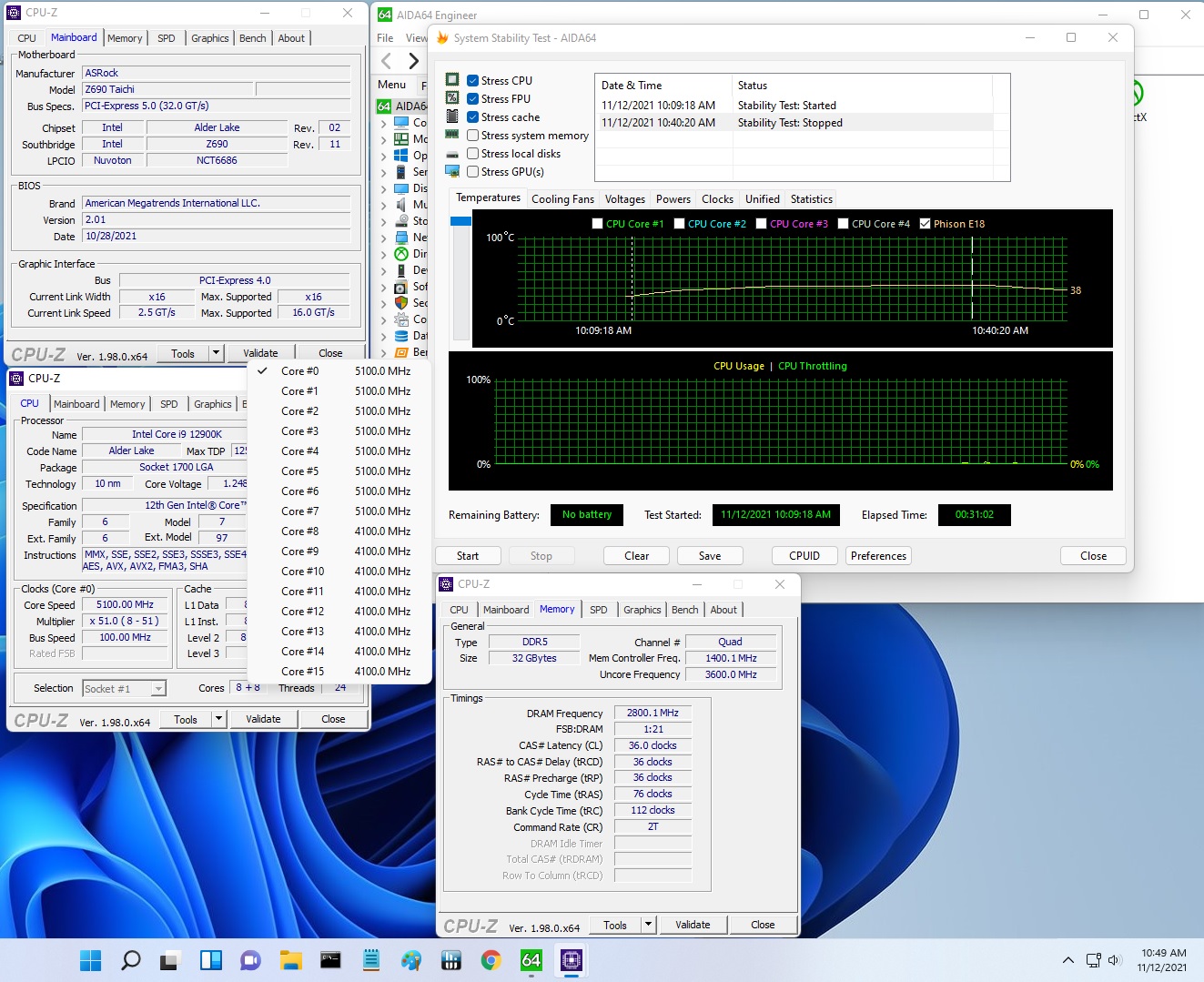Why you can trust Tom's Hardware
Our standard benchmarks and power tests are performed using the CPU’s stock frequencies (including any default boost/turbo), with all power-saving features enabled. We set optimized defaults in the BIOS and the memory by enabling the XMP profile. For this baseline testing, The Windows power scheme is set to balanced (default), so the PC idles appropriately. To get the most out of the Intel Alder Lake chips, you need to be on Windows 11 with its updated scheduler. In most cases, Windows 10 performs well. However, some tests (Cinebench R20, Corona and POVRay) take a significant hit. In short, if you’re going with Alder Lake, you must upgrade to Windows 11 for the best results across the board. That may change with patching and updates. We’ll keep you posted.
Synthetic Benchmarks
Synthetics are a great tool to determine how a board runs, as identical settings should produce similar performance results. Turbo boost wattage and advanced memory timings are places where motherboard makers can still optimize for either stability or performance, though, and those settings can impact some testing.
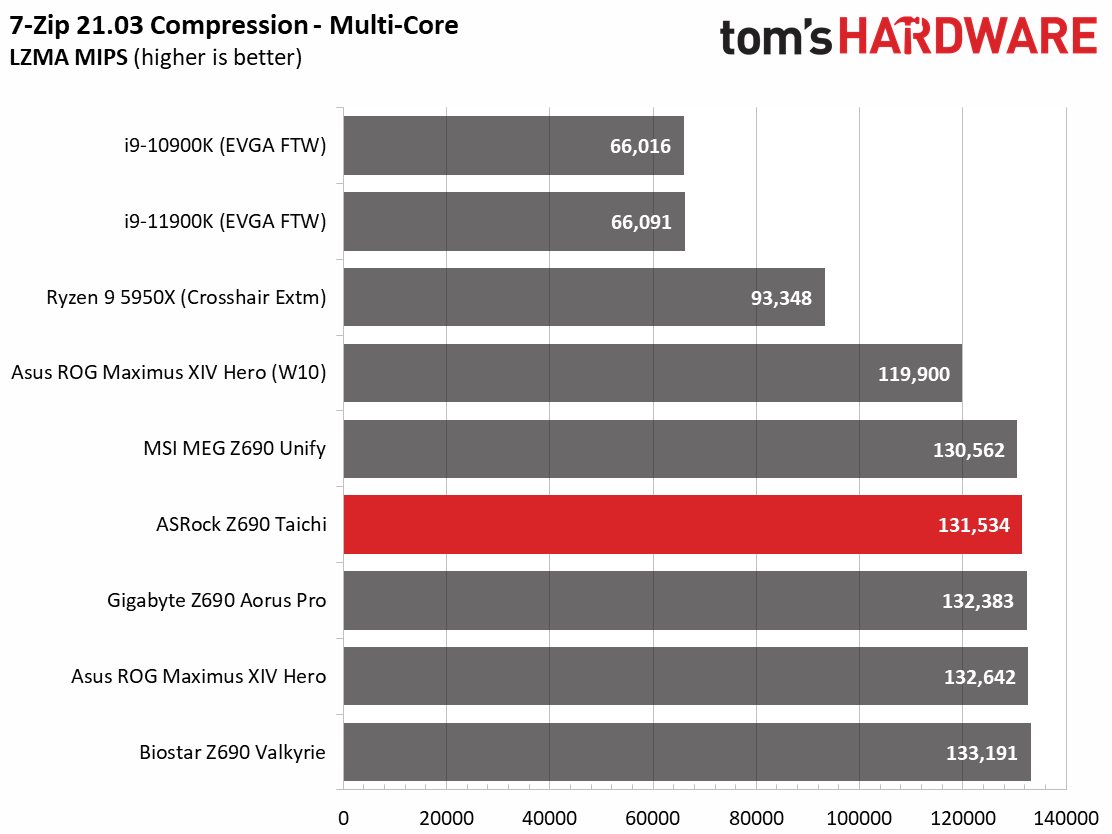
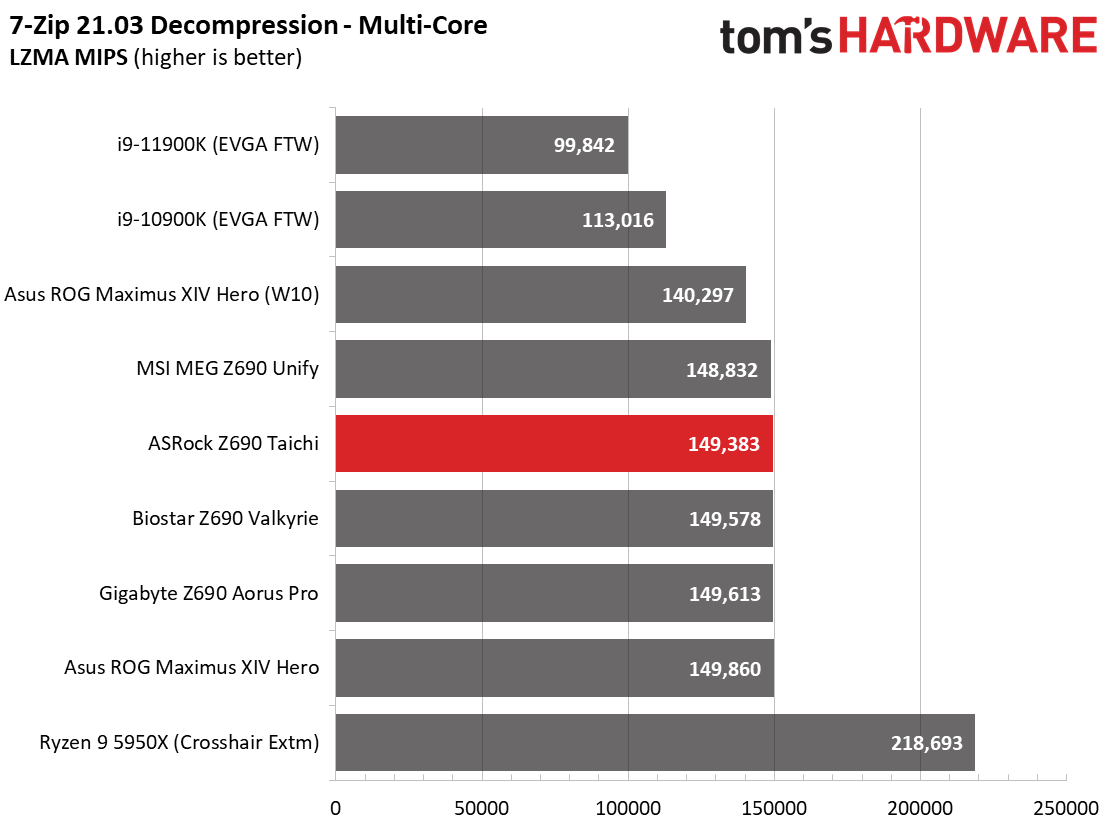
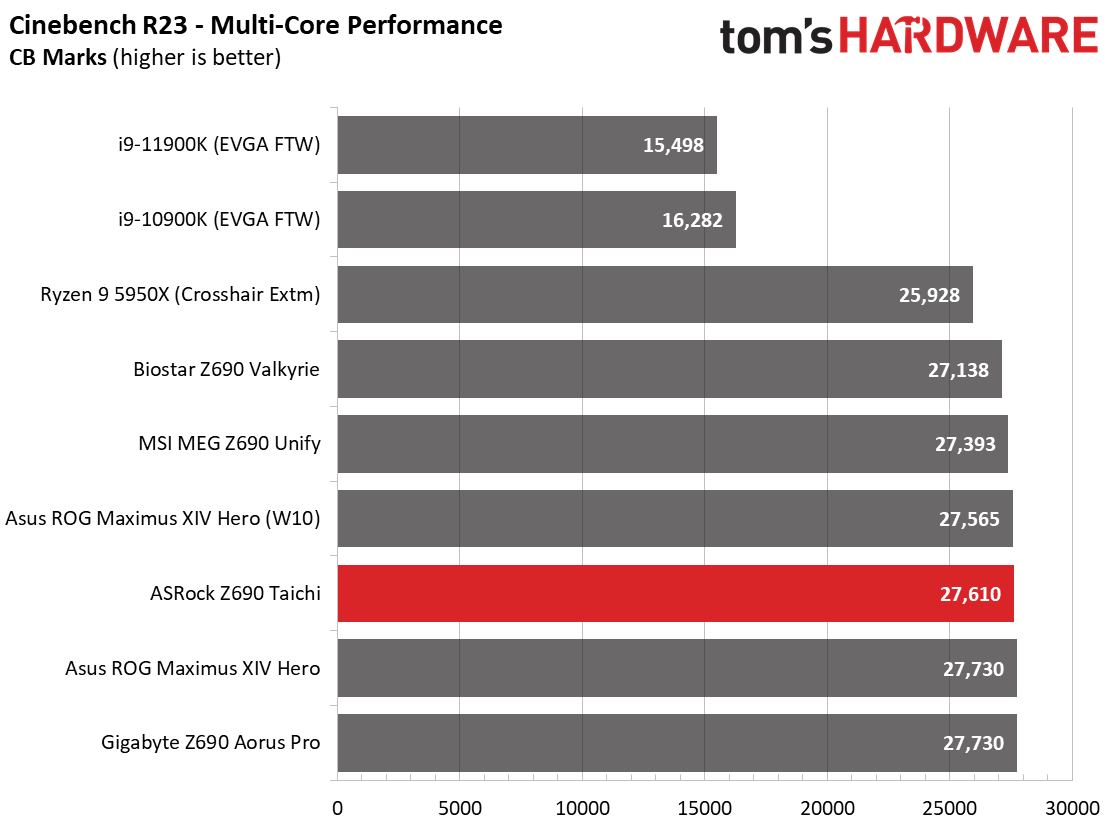

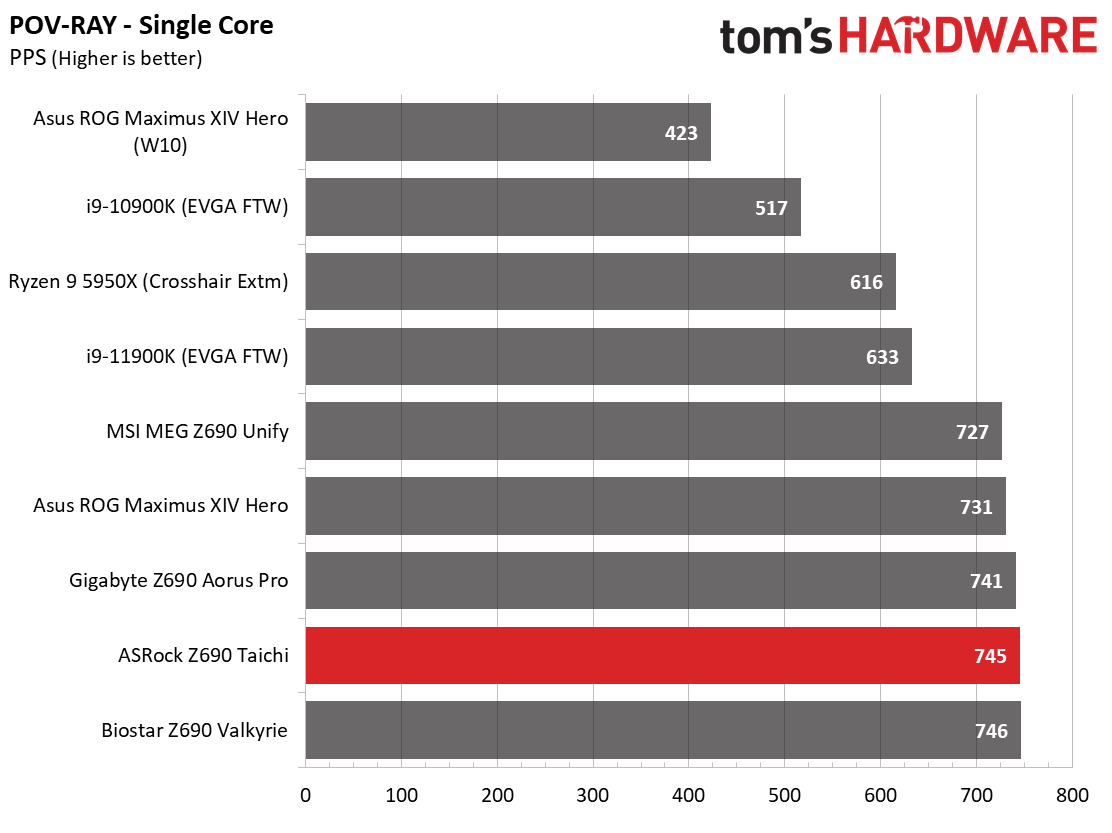
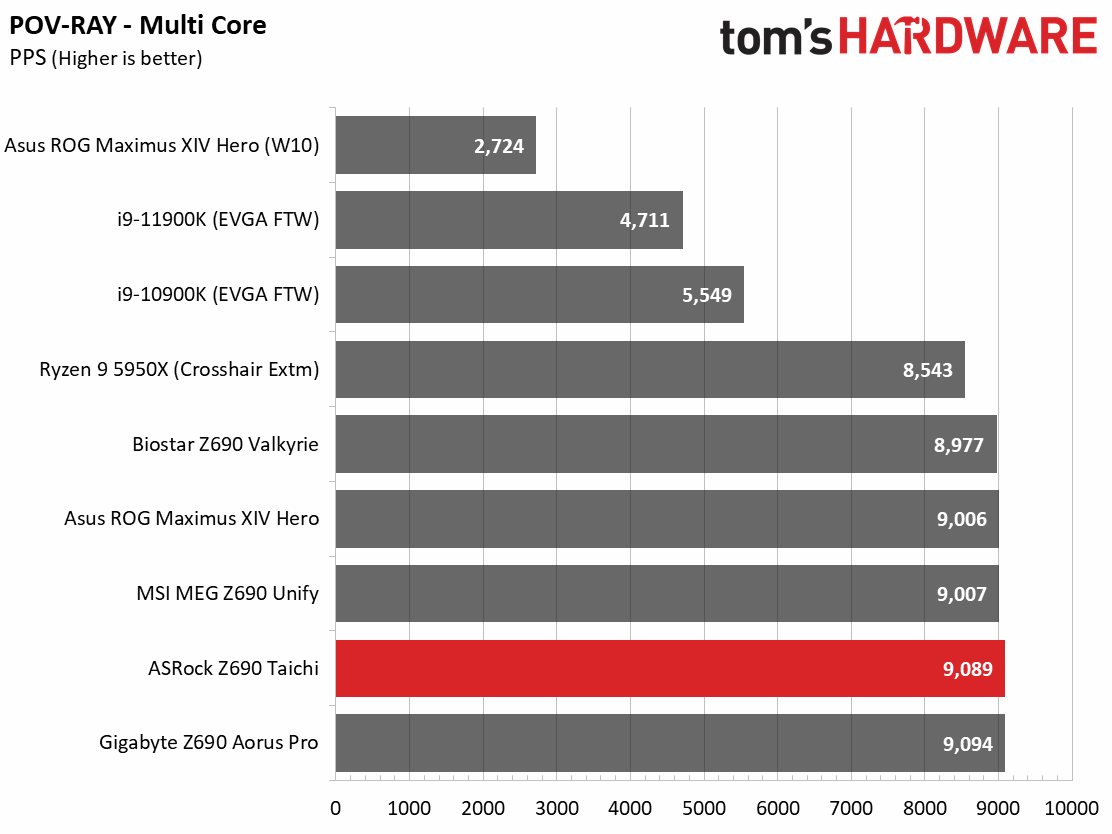
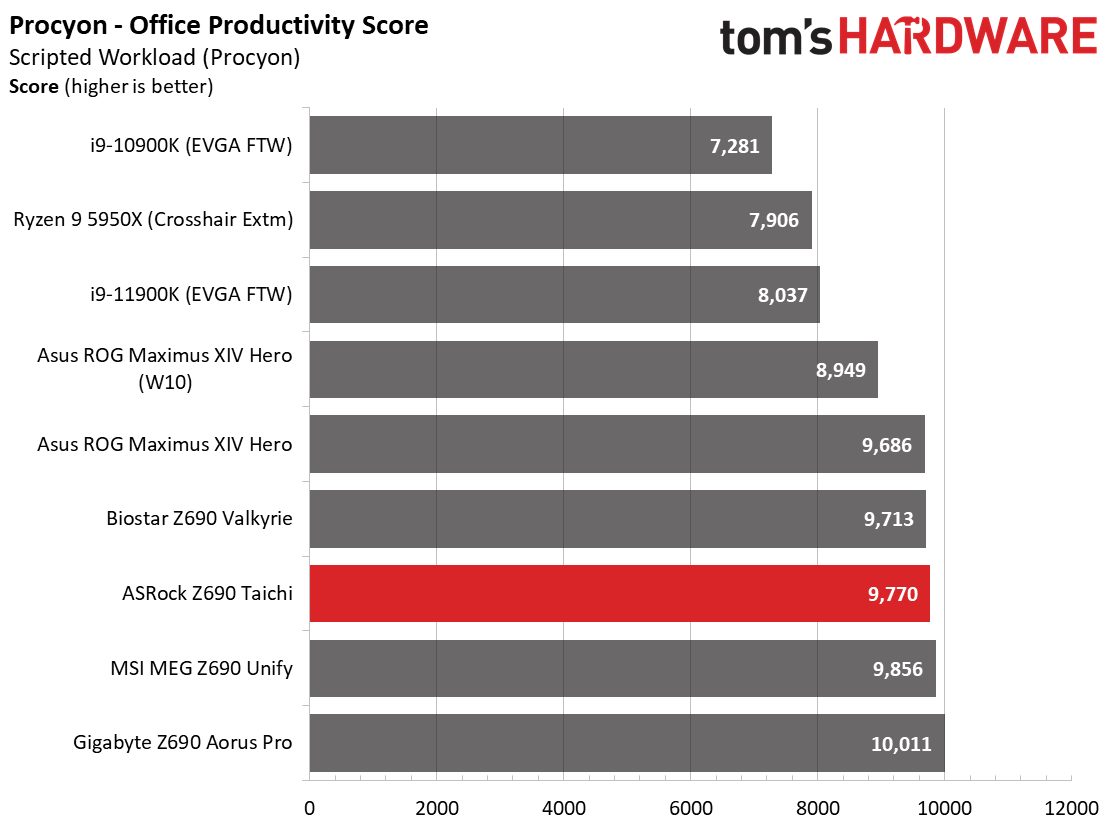
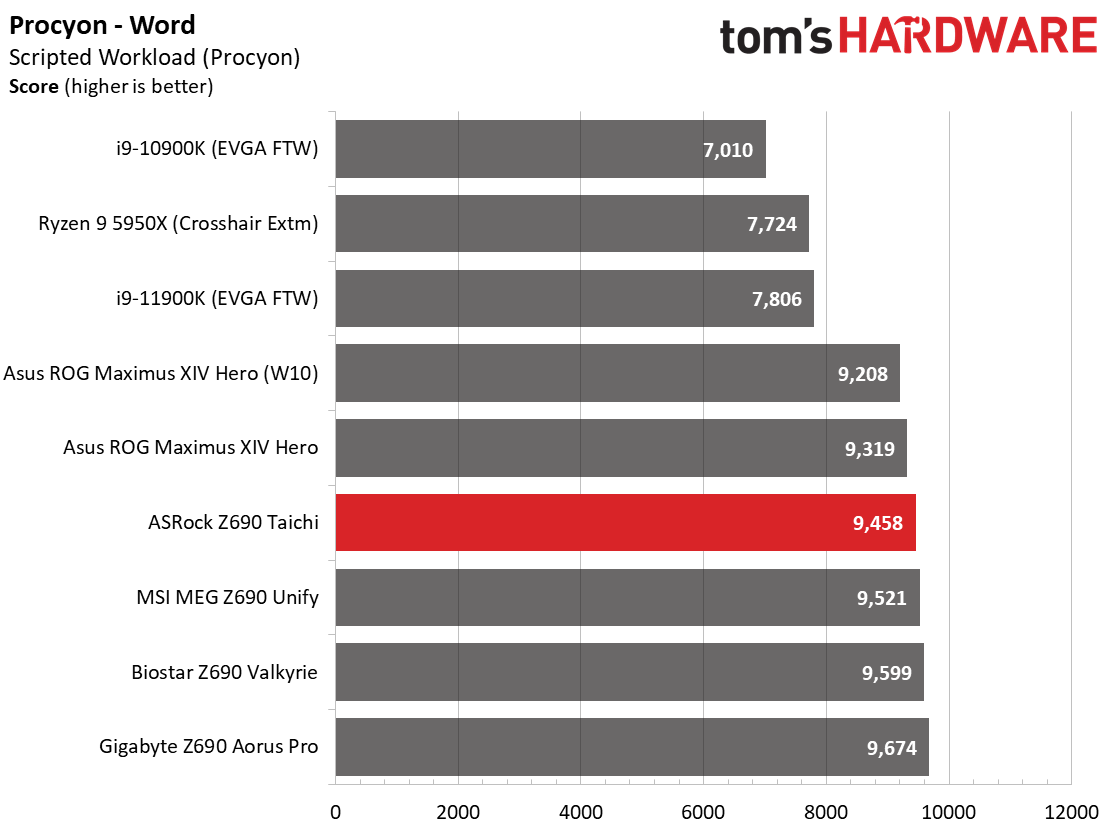
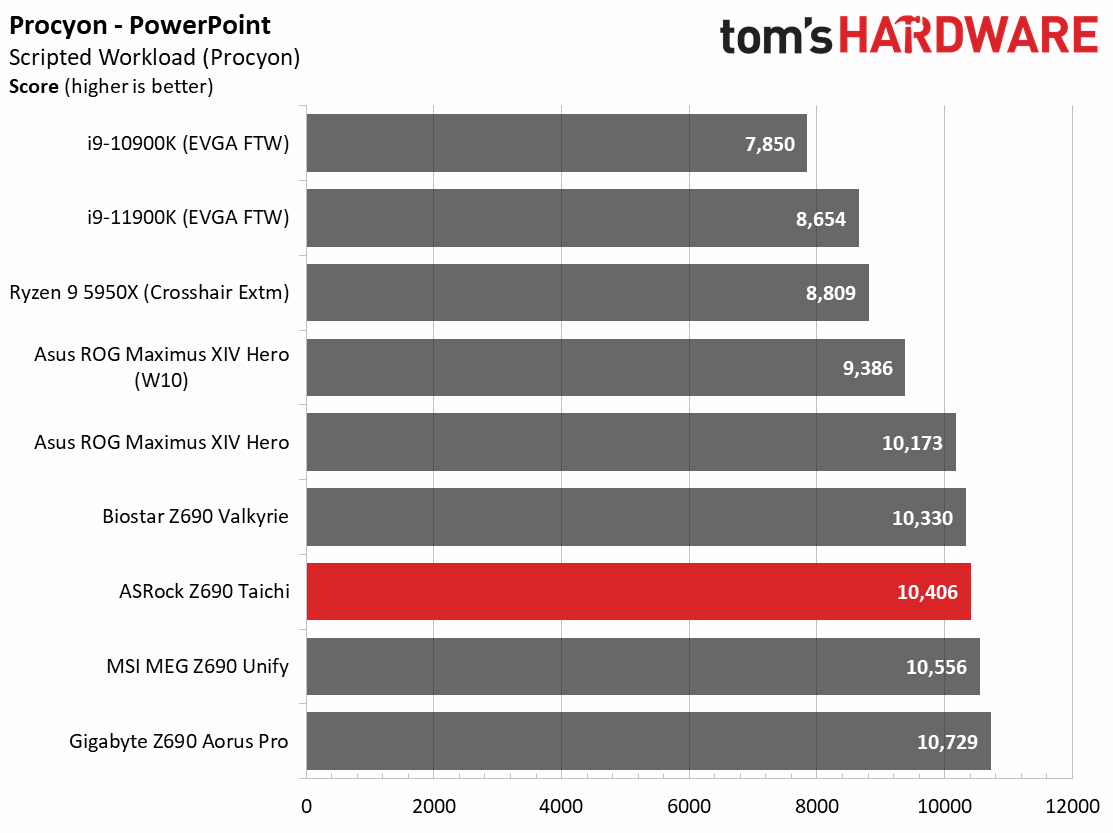
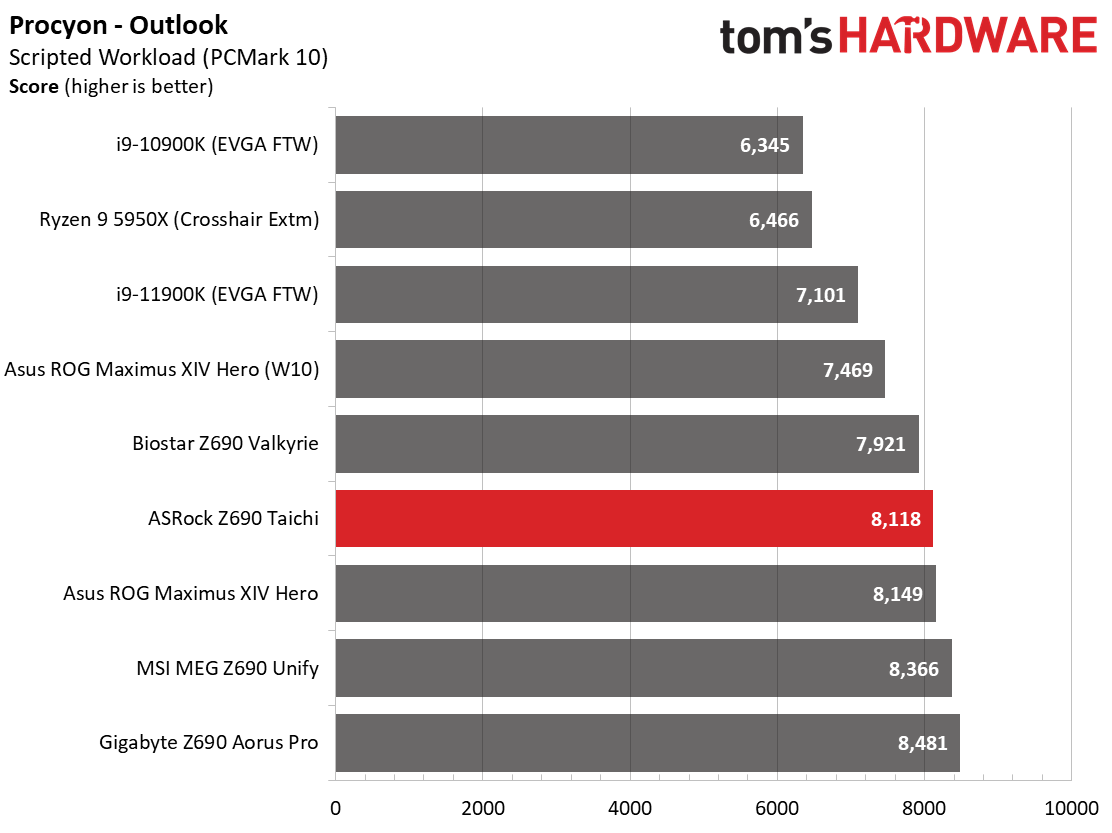


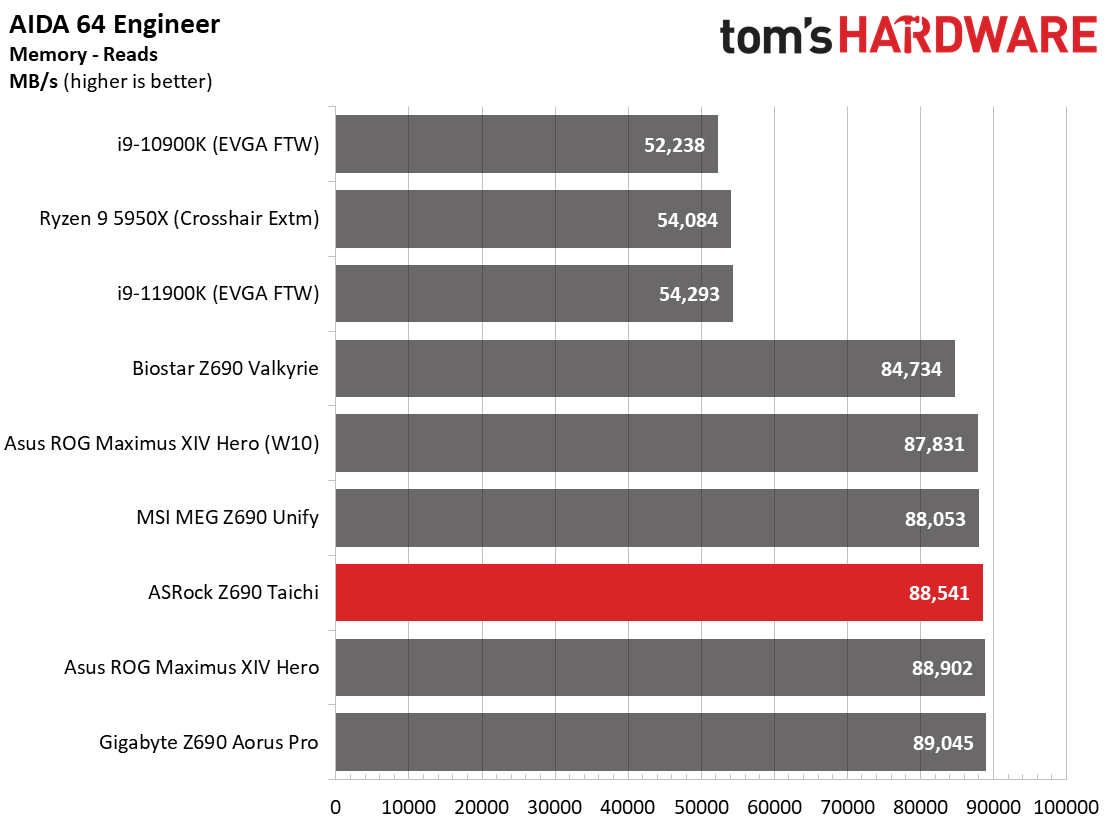
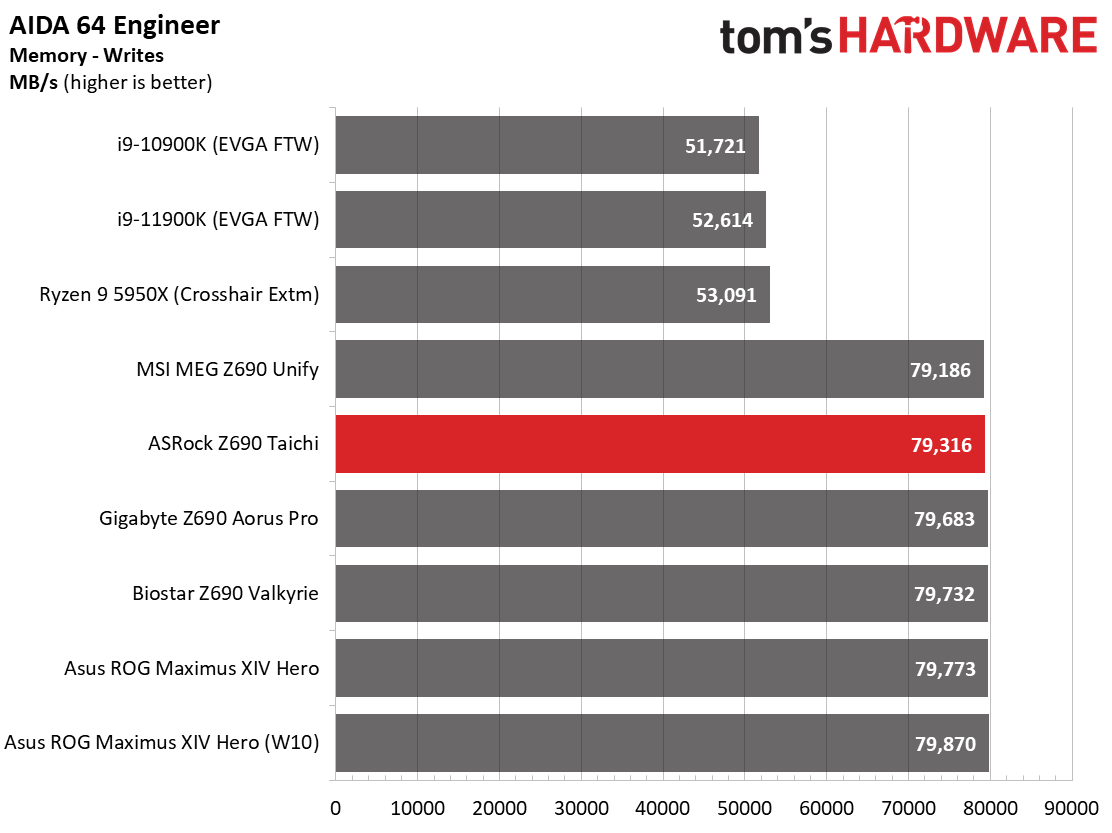

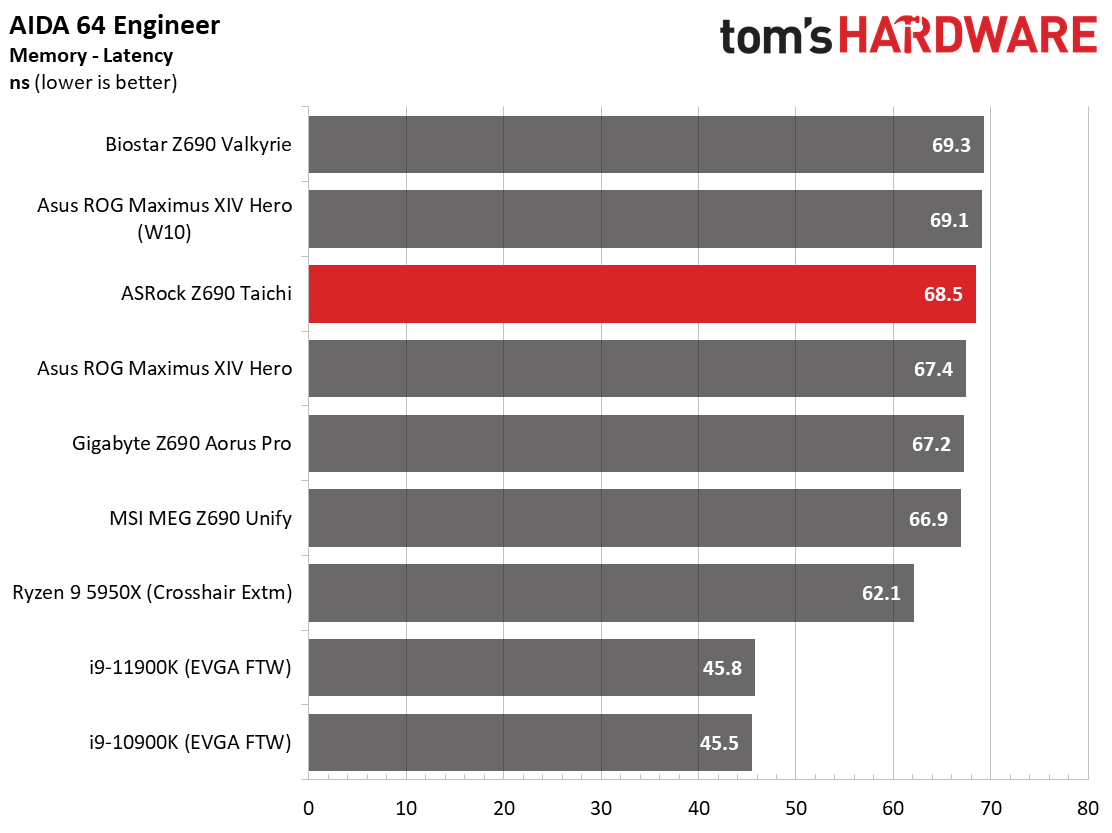
The Z690 Taichi traded punches with the boards we’ve tested so far. It wasn’t the fastest nor slowest in any of these tests. AIDA test results for memory told us the same story. There’s nothing out of the ordinary in our synthetic benchmarks and the performance difference between most of these results are negligible.
Timed Applications
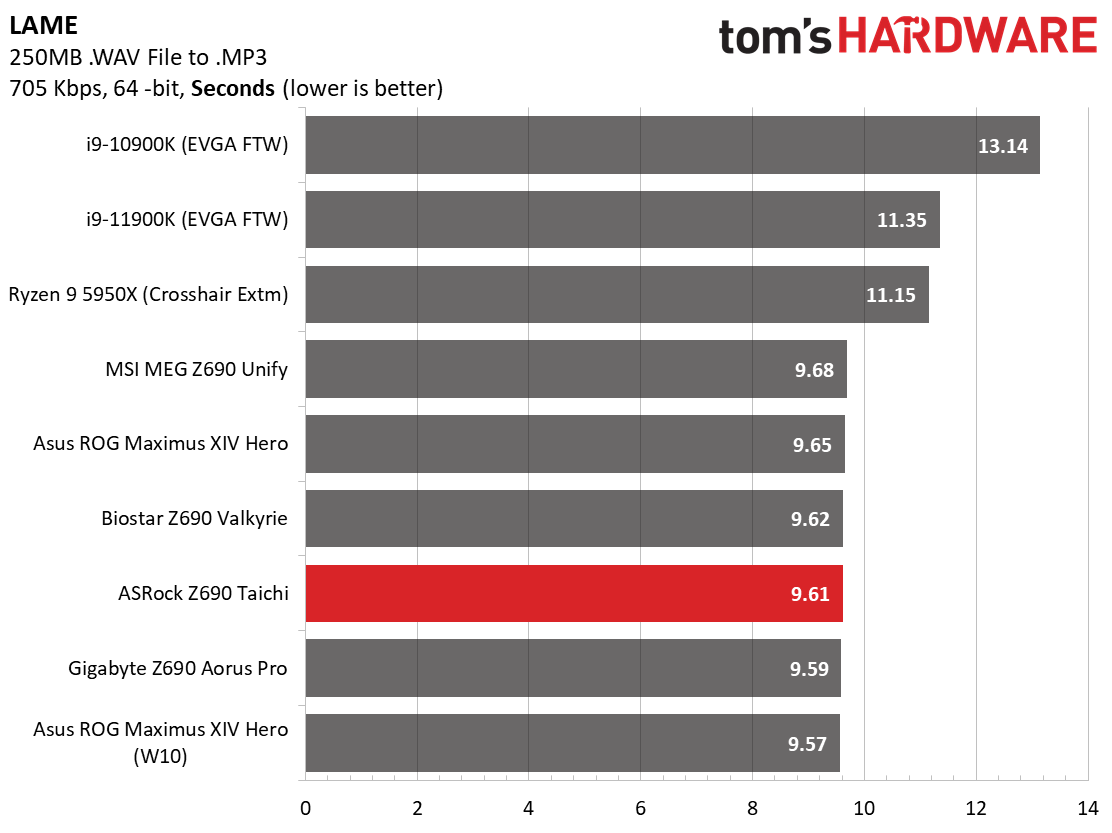


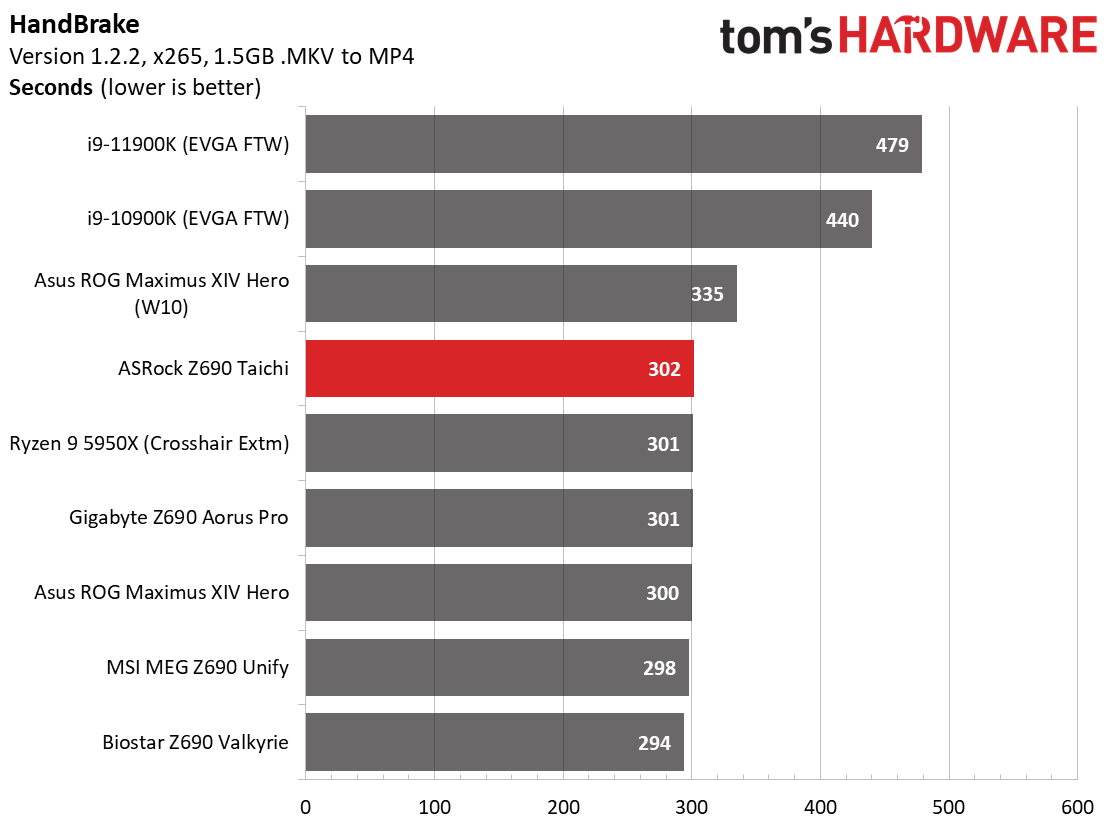
So far, our LAME tests on Z690 are still within 9/100ths of a second from worst to first. In this test, the Z690 Taichi was again average, running just 2/100ths of a second behind the fastest result. The 52-second time in Corona is tied with two other boards as the fastest result so far. During the x264 Handbrake transcoding, the Taichi completed the test in 112 seconds and tied for the quickest result with the Aorus Pro. The x265 transcoding result, however, landed the Taichi in last at 302 seconds. Most results were right around the 300-second mark, with the fastest coming from the Z690 Valkyrie at 294 seconds - not a big difference.
3D Games and 3DMark

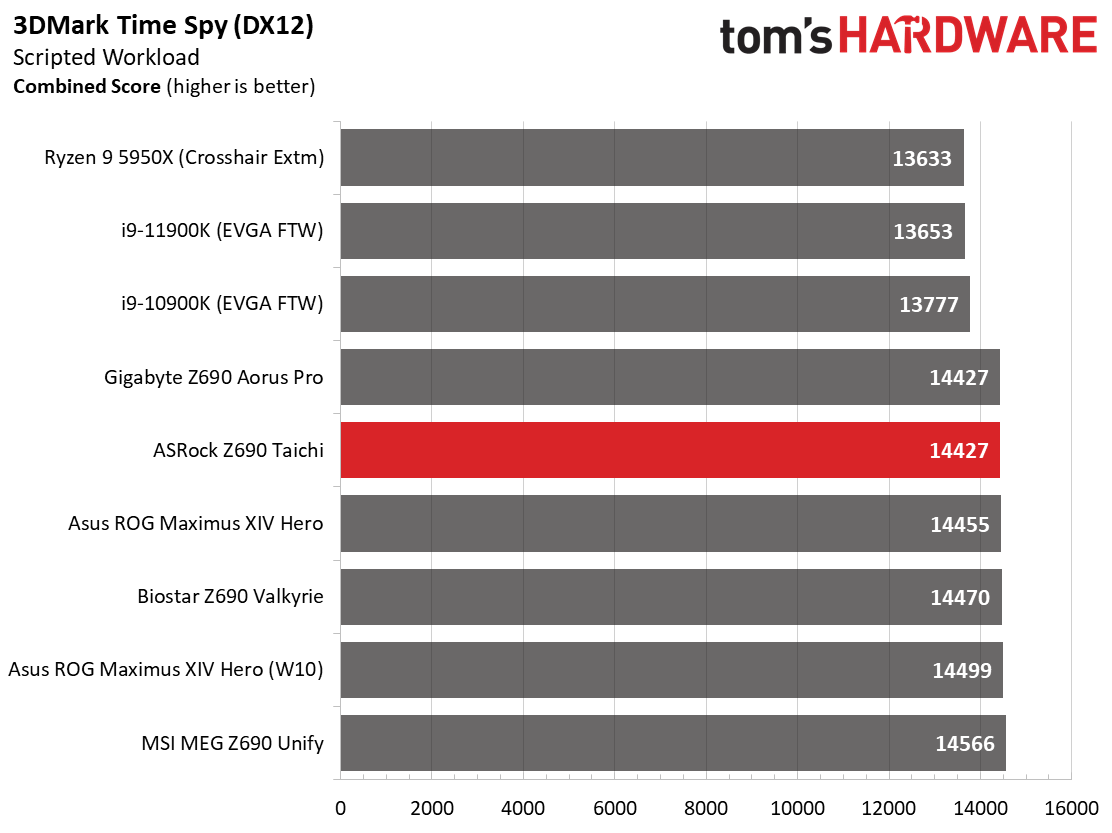
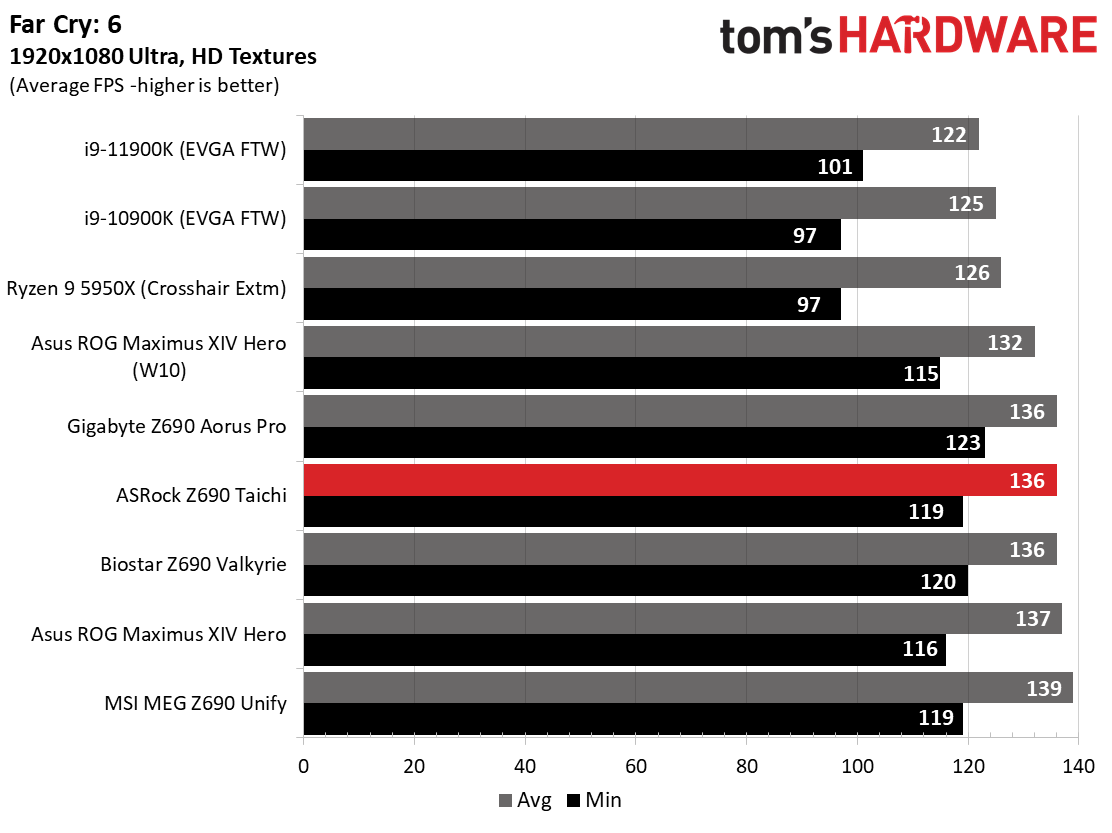
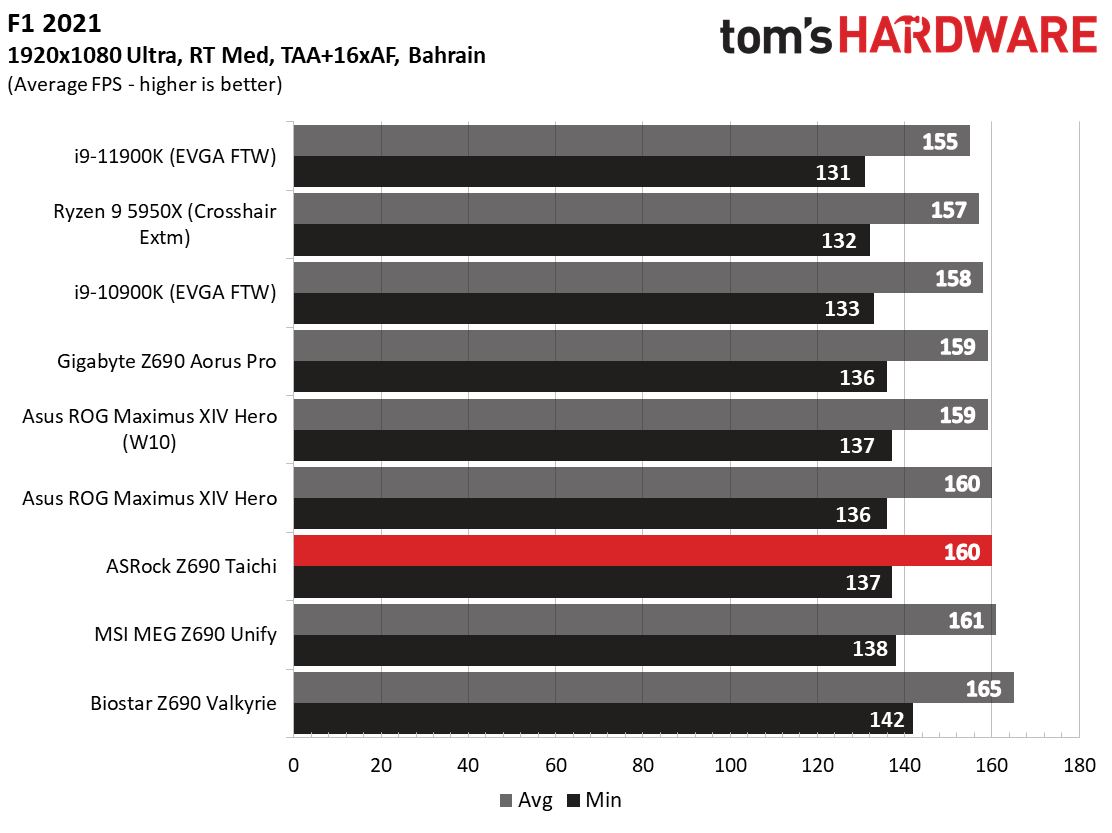
Starting with the launch of the Z690 chipset, we’ve updated our game tests. We’ve updated Far Cry: New Dawn to Far Cry 6 and shifted from F1 2020 to F1 2021. We run the games at 1920x1080 resolution using the Ultra preset (details listed above). As the resolution goes up, the CPU tends to have less of an impact. The goal with these settings is to determine if there are differences in performance at the most commonly used resolution with settings most people use or at least strive for. We expect the difference between boards in these tests to be minor, with most falling within the margin of error differences. We’ve also added a minimum FPS value, as that can affect your gameplay and immersion experience.
In F1 2021, the Z690 Taichi averaged 160 Frames Per Second (FPS) with minimums of 137 FPS, or just on the higher side of average for both metrics so far. The same goes for Far Cry 6. In this case, the Z690 Taichi averaged 136 FPS with a minimum of 119 FPS. It would be difficult to tell the difference between boards when gaming without staring at the frame counter.
In our synthetic benchmarks, our trend of not seeing a significant difference continues. 3DMark Time Spy scored 14,427 (tied for the lowest), while in Fire Strike Extreme, the Taichi broke the 17,000 point barrier at 17,046 the second-highest result. Here again, the difference between the tested boards is negligible.
Get Tom's Hardware's best news and in-depth reviews, straight to your inbox.
Power Consumption / VRM Temperatures
We used AIDA64’s System Stability Test with Stress CPU, FPU and Cache enabled for power testing, using the peak power consumption value. The wattage reading is from the wall via a Kill-A-Watt meter to capture the entire PC minus the monitor. The only variable that changes is the motherboard; all other parts are the same.
At idle, our Z690 Taichi consumed 68W, landing in the middle of our results. Load wattage peaked at 314W, which falls around the average for Z690 motherboards so far. Depending on the board and its default settings, you may see similar power and temperature profiles between stock and overclocked situations, and we run into that here as well. Leaving the board to its own devices yields the same 4.9/3.7 GHz clocks as the other boards. Out of the Z690 boards tested so far, the Taichi is the second most efficient, though in most cases, it would be difficult to see the difference on your electric bill.
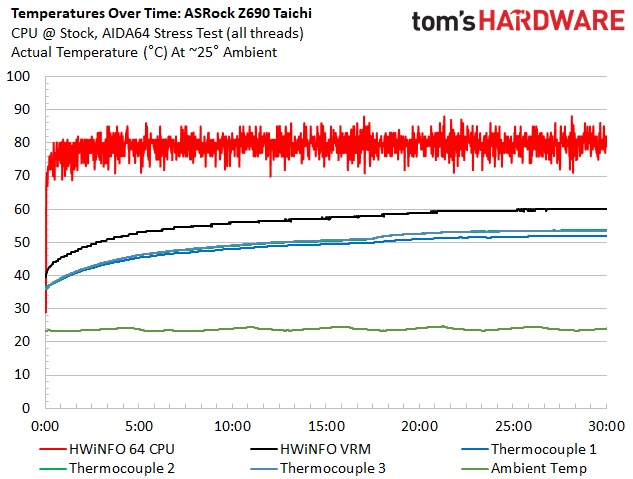


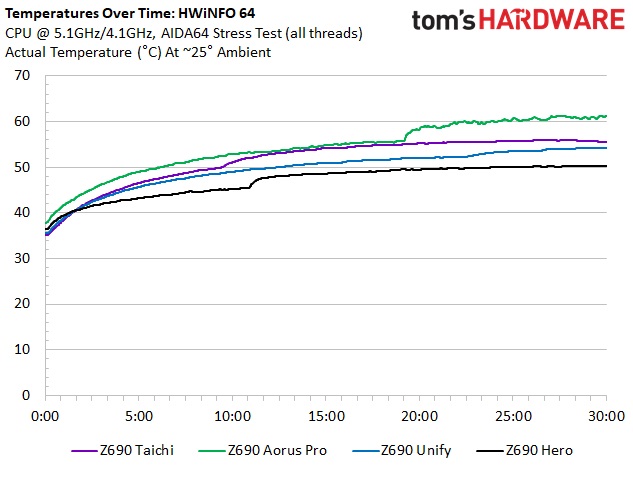
VRM temperatures on our Z690 Taichi topped out just above 54 degrees Celsius during stock testing and 56 degrees Celsius when overclocked. Since one of the VRM heatsinks is actively cooled, I expected to see lower temperatures. That said, the actively cooled VRM heatsinks are more than capable of keeping the MOSFETs and other power bits below running well within specifications. The fan does so without making a lot of noise either. The only thing holding you back is the cooling solution and limits of the CPU.
Overclocking
Overclocking with Alder Lake is a bit different than we’re used to due to the hybrid core configuration. Now, you can overclock the P and E cores separately, though they both use the same voltage domain. You can push one and not the other, or both, so there’s some flexibility. To that end, we set an overclock to 5.1 GHz across all P-cores and 4.1Ghz on all E-cores. This yields a 200 MHz bump on the P-cores and a 400 MHz increase on the E-cores. We’re topped out on the P-cores, primarily due to temperatures, but the more efficient E-cores still have some headroom.
Overclocking with the Z690 Taichi and the flagship 8+8-core/24-thread i9-12900K proved painless. Since we’ve found our required voltage with the Z690 Hero, we plugged in that 1.25V value for Vcore, adjusted LLC to Mode 1, and tested it successfully. According to CPUz, the voltage was 1.24V, so using Mode 1 effectively mitigates the vdroop.
On the memory side, we didn’t have a chance to dig in and play with DDR5 yet. We only had one kit available and a lot of testing to get this, and the Z690 Hero review out on time when we wrote this. That said, our current DDR5 5600 kit (from GSkill) is what we’re thinking is around the sweet spot, at least initially. To that end, we were able to set XMP and go, yielding a 600 MHz increase from the maximum rating of the platform. Here’s to hoping that prices come down on RAM over time as these DDR5 kits are expensive. Stay tuned for future reviews for memory overclocking.
Final Thoughts
After gathering data the past couple of weeks, we learned that overall, Intel has a solid processor in both performance and pricing with the i9-12900K. Between the addition of PCIe 5.0, DDR5, and the CPU, Intel’s performance matches or beats AMD. The Z690 Taichi in this review allowed the processor to reach its full potential with stock settings, trading punches with our other Z690 results. Overall performance on the Taichi proved to be average, which is a good result.
Along with the solid performance, the Z690 Taichi keeps the signature Taichi design aesthetic we’re used to with just a few subtle updates. Annoyingly, we didn’t see an increase in the M.2 socket or rear IO USB count, but some gamers will be happy that two are Lightning USB ports. Power delivery also saw a bump in both VRM phase count and the upgrade to 105A MOSFETs (from 90A). If you want to mine during your downtime and are concerned about the security of the OS, the Taichi offers a USB and SATA port that are not connected to the rest of the board.
As far as ways to improve, we’d like to see more USB ports on the rear IO. While we appreciate the addition of the USB AIC for wireless USB dongles, some may still find the six Type-A ports and two Thunderbolt 4 Type-C ports just aren’t enough. Another area the Taichi falls a bit short is with the M.2 socket count. Where most boards at this price have at least four (some up to six), there are only three here. This isn’t a deal-breaker, but if you’re planning to run more than three M.2 without an add-in card, you’ll have to look elsewhere.
There’s a lot of competition at this price point. This includes the Asus ROG Maximus Z690 Hero ($599.99), MSI MEG Z690 Ace ($599.99), and the much less expensive Gigabyte Z690 Aorus Master ($469.99). While all of these premium motherboards would be a great Alder Lake starting point, the Z690 Aorus Master offers the best overall value, selling for nearly $100 less than the others and sporting similar, premium hardware.
MORE: Best Motherboards
MORE: How To Choose A Motherboard
MORE: All Motherboard Content

Joe Shields is a staff writer at Tom’s Hardware. He reviews motherboards and PC components.
-
truerock I hate it when a reviewer downgrades a product for not having enough obsolete technology.Reply
Thank god Joe Shields has finally decided he can live without floppy disk drives,
How many decades before he can give up his type-A/B USB devices?
In my opinion, if you need obsolete technology, use an obsolete PC. -
larkspur AGP cards are obsolete, floppies are obsolete. USB-A continues to be ubiquitous in the world of peripherals. I think only three m.2 slots is definitely a head-scratcher on a board of this class. I mean even a "cheapie" $220 MSI Pro Z690-A has four m.2 slots. This is a $589 board, for goodness sake!Reply -
JarredWaltonGPU Reply
The cons are not the only negative points, they're things to consider. For some people, six USB Type-A is limiting, and three M.2 might be as well. The biggest issue for me would be the price. For $580 a motherboard should be near perfection, and this isn't. Hence, 7/10 score.truerock said:I hate it when a reviewer downgrades a product for not having enough obsolete technology.
Thank god Joe Shields has finally decided he can live without floppy disk drives,
How many decades before he can give up his type-A/B USB devices?
In my opinion, if you need obsolete technology, use an obsolete PC. -
wifiburger and.... I would say not many will buy / have this board since DDR5 is nowhere to be foundReply -
Co BIY What is the advantage of the Lightning gaming ports ? Is this primarily for VR ?Reply
Seems like this is a major feature of a board that otherwise is overpriced.
Does it work? is their actually lower latency in competitive gaming ? Will it help me go pro?
Board/PSU only USB bios update seems like a nice feature but is that standard at this level ?
I think the easy replaceability/upgradability of the board cooling fan is an important feature to cover. I was concerned that an included fan was a point of failure but the fan is easily replaceable.
(Updated: After looking at this on the ARrock website I have two impressions:
1 - Game controller independence seems like a neat concept that is worth testing. They claim that mouse and keyboard inputs run on the same USB controller interfere with each other interrupting your gameplay. They separate the mouse and keyboard inputs sending the mouse through a USB controller and Keyboard through a separate PCIe controller eliminating the interference.
2 - The naming, marketing, and labeling of this feature is dishonest and probably intentionally misleading. It confuses "High-speed Thunderbolt USB" ports (40gbps) with this separated I/O controller technology "Lightning Gaming USB" ports in a way that confused me and I'm a fairly savvy consumer of motherboards. ) -
basisunus I do some photo-video editing, graphics programming, and gaming on my home computer. I had specific requirements for a motherboard when the Z590 platform came around and I was considering an upgrade.Reply
First, I want one x16 PCIE Gen4 slot for a graphics card.
Second, I need a x1 and a x4 slots for a sound card and a video capture card.
Third, I want two M.2 slots for Gen4 NVMe drives and configured to RAID0.
Fourth, I want a Thunderbolt port for testing external PCIE devices. This could be done via onboard connectors or an add-in card.
Furthermore, I want no PCIE lanes are shared among all above devices.
Other expectations include:
An Intel CPU with integrated GPU for UHD Bluray playback,
8x8 PCIE support for dual graphics card,
Wifi and Bluetooth,
Integrated IO shield for better ESD protection on a testbench-style case.
I skipped the Z590 platform because I didn't find a single motherboard that met the major requirements. For the Z690 platform, the Asrock Taichi is the only one that meets the requirements. I preordered it when the order was open. It's still on preorder. But I never looked at other boards. It seems it might take me a long time to finally finish the build because of the shortages.
